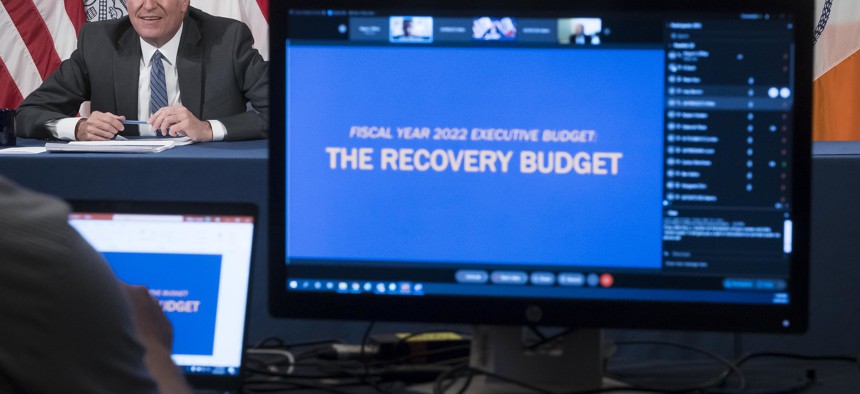After a doomsday budget last year and a cautious preliminary budget in January, New York City Mayor Bill de Blasio proposed “the recovery budget” for fiscal year 2022, which would be the largest in the city’s history. Much like the state government, where lawmakers approved a historically large spending plan earlier this month, an influx of federal cash and better-than-projected revenue estimates led de Blasio to recommend a spending spree, as the city attempts to recover from the coronavirus pandemic.
De Blasio proposed a $98.6 billion budget, which is over $6 billion bigger than his preliminary budget in January. At the time, the mayor said he avoided drastic cuts, but he still included some deep cost-saving measures to close a projected deficit of more than $5 billion. The new executive budget is also over $10 billion bigger than the “wartime” budget the city approved last year closer to the beginning of the pandemic.
Now, de Blasio wants to increase spending on schools, senior centers and mental health crisis response, and he does not suggest cutting the New York City Police Department budget.
Speaking at a virtual press conference Monday afternoon, the mayor painted an optimistic portrait of the city and its road to recovery as he presented his executive spending plan. “This is a good news budget if ever there was one,” de Blasio said, adding that it allows the government to “invest in working people in the city in ways we've never been able to achieve before.” But de Blasio already received some criticism for his plan, namely his use of one-time federal dollars to fund recurring program costs. “No matter how worthy the programs may be, this sets them up to fall off future budget cliffs,” Citizens Budget Commission President Andrew Rein said in a statement. He also called the cost-savings program “anemic” as he criticized it for not relying on recurring spending cuts.
Asked by a reporter at the briefing about the fiscal situation he’s leaving for his successor, de Blasio said he’s confident that his spending priorities will boost future revenues, presumably through greater economic growth. “Sometimes you have to spend money to make money,” he said. “This is a case where we have to take full advantage of this recovery moment, we have to double down now, and that’s going to give the next administration to move this city forward.” However, de Blasio’s plan projects outyear budget gaps of around $4 billion in each of the next fiscal years, starting in 2023, that his successor will have to address.
The mayor and the City Council will now work to reach a budget agreement before the July 1 deadline. Although last year went down to the wire over funding for police, the Council speaker and mayor usually come to a handshake agreement several weeks before the deadline.
With an ambitious budget in the works, here are some of the key numbers:
$98.6 billion – The total size of the executive budget, the largest in the city’s history.
$13 billion – The amount of federal aid the city has to spend before 2024, including $6 billion in unrestricted aid and $7 billion in cash for schools.
$3.9 billion – The amount of savings from cost-cutting the city achieved since June of last year, including $603 million in the new executive budget.
319,100 – The projected city employee headcount for the next fiscal year, representing about a 5,000 person increase from where it stands now after cuts the past year.
400,000 – The number of private sector jobs the budget projects will be added in the city between now and the end of calendar year 2021.
$112 million – The amount de Blasio wants to spend on expanding civilian response to mental health calls to every police precinct in the city.
1,000 – The number of acres a new Manhattan Greenway will provide once completed in 2029.
$3.2 billion – The total increase to education spending.
$3.9 billion – The Fiscal Year 2023 projected budget gap.
$4.59 billion – The size of the city’s budget reserves with new investments. The number combines the general reserve fund, the relatively new rainy day fund and the retiree health benefits trust
100% – The percentage of three year olds who will have access to a free 3-K seat starting in 2023.
0 – The change to the uniformed headcount of the NYPD, as its budget remains about flat.
$1 billion – The amount of unspecified labor savings de Blasio included in his preliminary budget that are no longer needed.
25 – The number of new senior centers the city plans to open in currently underserved communities of color.


